
Minnesota Historical Society
Encyclopedia
The Minnesota Historical Society (MHS) is a private, non-profit educational and cultural institution dedicated to preserving the history of the U.S. state of Minnesota
. It was founded by the territorial
legislature
in 1849, almost a decade before statehood. The Society is named in the Minnesota Constitution
. It is headquartered in the Minnesota History Center
in downtown St. Paul
.
MHS currently holds a collection of nearly 550,000 books, 37,000 maps, 250,000 photographs, 165,000 historical artifacts, 800,000 archaeological items, 38000 cubic feet (1,076 m³) of manuscripts, 45000 cubic feet (1,274.3 m³) of government records, 5,500 paintings, prints and drawings; and 1,300 moving image items.
s and 16 others are on the National Register of Historic Places
(NRHP). Seven sites lie within Minnesota state parks, and three are elements of the Mississippi National River and Recreation Area
.
Minnesota
Minnesota is a U.S. state located in the Midwestern United States. The twelfth largest state of the U.S., it is the twenty-first most populous, with 5.3 million residents. Minnesota was carved out of the eastern half of the Minnesota Territory and admitted to the Union as the thirty-second state...
. It was founded by the territorial
Minnesota Territory
The Territory of Minnesota was an organized incorporated territory of the United States that existed from March 3, 1849, until May 11, 1858, when the eastern portion of the territory was admitted to the Union as the State of Minnesota.-History:...
legislature
Minnesota Legislature
The Minnesota Legislature is the legislative branch of government in the U.S. state of Minnesota. It is a bicameral legislature located at the Minnesota Capitol in Saint Paul and it consists of two houses: the lower Minnesota House of Representatives and the Minnesota Senate...
in 1849, almost a decade before statehood. The Society is named in the Minnesota Constitution
Minnesota Constitution
The Constitution of the State of Minnesota, USA was initially approved by the residents of Minnesota Territory in a special election held on October 13, 1857, and was ratified by the United States Senate on May 11, 1858, marking the admittance of Minnesota to the Union...
. It is headquartered in the Minnesota History Center
Minnesota History Center
The Minnesota History Center is a museum and library which serves as the headquarters for the Minnesota Historical Society. It is located near downtown Saint Paul, Minnesota and is considered one of the finest public buildings of Minnesota....
in downtown St. Paul
Saint Paul, Minnesota
Saint Paul is the capital and second-most populous city of the U.S. state of Minnesota. The city lies mostly on the east bank of the Mississippi River in the area surrounding its point of confluence with the Minnesota River, and adjoins Minneapolis, the state's largest city...
.
MHS currently holds a collection of nearly 550,000 books, 37,000 maps, 250,000 photographs, 165,000 historical artifacts, 800,000 archaeological items, 38000 cubic feet (1,076 m³) of manuscripts, 45000 cubic feet (1,274.3 m³) of government records, 5,500 paintings, prints and drawings; and 1,300 moving image items.
State Historic Sites
The Minnesota Historical Society operates 31 historic sites and museums, 26 of which are open to the public. MHS manages 14 sites directly and eight in partnerships where the society maintains the resources and provides funding. Five sites are being held for preservation but are closed to public access, and three are self-guided sites with interpretive signage. Seven of the sites are National Historic LandmarkNational Historic Landmark
A National Historic Landmark is a building, site, structure, object, or district, that is officially recognized by the United States government for its historical significance...
s and 16 others are on the National Register of Historic Places
National Register of Historic Places
The National Register of Historic Places is the United States government's official list of districts, sites, buildings, structures, and objects deemed worthy of preservation...
(NRHP). Seven sites lie within Minnesota state parks, and three are elements of the Mississippi National River and Recreation Area
Mississippi National River and Recreation Area
The Mississippi National River and Recreation Area protects a and corridor along the Mississippi River from the cities of Dayton and Ramsey, Minnesota to just downstream of Hastings, Minnesota. This includes the stretch of Mississippi River which flows through Minneapolis and St. Paul, Minnesota...
.
| Site name | Image | Location | Era of features | Year added to MHS | Management | Remarks |
|---|---|---|---|---|---|---|
| Alexander Ramsey House Alexander Ramsey House The Alexander Ramsey House, located at 265 Exchange Street, South in Saint Paul, Minnesota is the former residence of Alexander Ramsey, who served as the first governor of Minnesota Territory and the second governor of the state of Minnesota.... |
St. Paul Saint Paul, Minnesota Saint Paul is the capital and second-most populous city of the U.S. state of Minnesota. The city lies mostly on the east bank of the Mississippi River in the area surrounding its point of confluence with the Minnesota River, and adjoins Minneapolis, the state's largest city... |
1872–1964 | 1964 | Direct | Home of Minnesota governor and U.S. Congressman Alexander Ramsey Alexander Ramsey Alexander Ramsey was an American politician. He was born near Harrisburg, Pennsylvania.Alexander Ramsey was elected from Pennsylvania as a Whig to the U.S. House of Representatives and served in the 28th and 29th congresses from March 4, 1843 to March 4, 1847... with original furnishings. NRHP National Register of Historic Places The National Register of Historic Places is the United States government's official list of districts, sites, buildings, structures, and objects deemed worthy of preservation... |
|
| Birch Coulee Battlefield Birch Coulee Battlefield Birch Coulee was the site of the Battle of Birch Coulee. It was listed on the National Register of Historic Places in 1973.-External links:* *... |
 |
Morton Morton, Minnesota Morton is a city in Renville County, Minnesota, United States. The population was 411 at the 2010 census.-Geography:According to the United States Census Bureau, the city has a total area of , of which, of it is land and of it is water.U.S... |
Self-guided | Site of the Battle of Birch Coulee Battle of Birch Coulee The Battle of Birch Coulee occurred September 2, 1862 during the Dakota War of 1862. After the Battle of Fort Ridgely and the Battle of New Ulm, Colonel Henry Hastings Sibley was planning to punish the Sioux and to obtain the release of the settlers they were holding captive... , the deadliest battle for U.S. troops in the Dakota War of 1862 Dakota War of 1862 The Dakota War of 1862, also known as the Sioux Uprising, was an armed conflict between the United States and several bands of the eastern Sioux. It began on August 17, 1862, along the Minnesota River in southwest Minnesota... . NRHP National Register of Historic Places The National Register of Historic Places is the United States government's official list of districts, sites, buildings, structures, and objects deemed worthy of preservation... . |
||
| Charles A. Lindbergh House Charles A. Lindbergh State Park Charles A. Lindbergh State Park is a 569 acre Minnesota state park on the outskirts of Little Falls. The park was once the farm of Congressman Charles August Lindbergh and his son Charles Lindbergh, the famous aviator. Their restored 1906 house and two other farm buildings are within the park... |
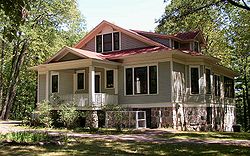 |
Charles A. Lindbergh State Park Charles A. Lindbergh State Park Charles A. Lindbergh State Park is a 569 acre Minnesota state park on the outskirts of Little Falls. The park was once the farm of Congressman Charles August Lindbergh and his son Charles Lindbergh, the famous aviator. Their restored 1906 house and two other farm buildings are within the park... |
1906–1920 | Direct | House of U.S. Congressman Charles August Lindbergh Charles August Lindbergh Charles August Lindbergh Sr. was a United States Congressman from Minnesota's 6th congressional district from 1907 to 1917... and his son, aviator Charles Lindbergh Charles Lindbergh Charles Augustus Lindbergh was an American aviator, author, inventor, explorer, and social activist.Lindbergh, a 25-year-old U.S... . National Historic Landmark National Historic Landmark A National Historic Landmark is a building, site, structure, object, or district, that is officially recognized by the United States government for its historical significance... |
|
| Comstock House | Moorhead Moorhead, Minnesota Moorhead is a city in Clay County, Minnesota, United States, and the largest city in northwest Minnesota. The population was 38,065 at the 2010 Census. It is the county seat of Clay County.... |
1882 | Partnership | Restored home of U.S. Congressman and businessman Solomon Comstock Solomon Comstock Solomon Gilman Comstock was a U.S. Representative from Minnesota as a member of the 51st Congress of the United States of America.-Biography:... with its original furnishings. NRHP National Register of Historic Places The National Register of Historic Places is the United States government's official list of districts, sites, buildings, structures, and objects deemed worthy of preservation... |
||
| Folsom House | Taylors Falls Taylors Falls, Minnesota As of the census of 2000, there were 951 people, 369 households, and 247 families residing in the city. The population density was 255.6 people per square mile . There were 386 housing units at an average density of 103.7 per square mile... |
1854–1968 | 1968 | Partnership | Restored home of businessman, politician, and historian W.H.C. Folsom with its original furnishings. | |
| Forest History Center Forest History Center The Forest History Center is one of 26 sites run by the Minnesota Historical Society. Located in Grand Rapids, Minnesota, the center focuses on displaying the historical and cultural impact that Minnesota's forests have had on people and the community. Historically, logging was a large economic... |
Grand Rapids Grand Rapids, Minnesota As of the census of 2000, there were 7,764 people, 3,446 households, and 1,943 families residing in the city. The population density was 1,057.8 people per square mile . There were 3,621 housing units at an average density of 493.3 per square mile... |
1900–1934 | Direct | Recreated logging camp and exhibits on humankind's relationship with Minnesota's forests. | ||
| Fort Renville | Lac qui Parle State Park Lac Qui Parle State Park Lac qui Parle State Park is a Minnesota state park near Watson. Lac qui Parle is a French translation of the native Dakota name, meaning "lake which speaks"... |
1822–1846 | Preservation | Location of a fur trading post established by Joseph Renville Joseph Renville Joseph Renville was an interpreter, translator, and an important figure in dealings between white men and Dakota Indians in Minnesota. He contributed to the translation of Christian religious texts in to the Dakota language. The hymnal Dakota dowanpi kin, was "composed by J... . |
||
| Fort Ridgely Fort Ridgely Fort Ridgely was a United States Army outpost near the Dakota reservation in southwestern Minnesota . Built between 1853–1855, it played an important role in the Dakota War of 1862... |
 |
Fort Ridgely State Park Fort Ridgely State Park Fort Ridgely State Park is a Minnesota state park on the Minnesota River south of Fairfax, Minnesota. It preserves Fort Ridgely and a site important to the Dakota War of 1862.... |
1853–1867 | Partnership | Fort built to keep the peace around a Dakota reservation, but attacked twice during the Dakota War of 1862 Dakota War of 1862 The Dakota War of 1862, also known as the Sioux Uprising, was an armed conflict between the United States and several bands of the eastern Sioux. It began on August 17, 1862, along the Minnesota River in southwest Minnesota... . NRHP National Register of Historic Places The National Register of Historic Places is the United States government's official list of districts, sites, buildings, structures, and objects deemed worthy of preservation... |
|
| Grand Mound | International Falls International Falls, Minnesota International Falls is a city in and the county seat of Koochiching County, Minnesota, United States. The population was 6,424 at the 2010 census.... |
1971 | Preservation | Five burial mounds Tumulus A tumulus is a mound of earth and stones raised over a grave or graves. Tumuli are also known as barrows, burial mounds, Hügelgrab or kurgans, and can be found throughout much of the world. A tumulus composed largely or entirely of stones is usually referred to as a cairn... include the largest prehistoric structure remaining in the Upper Midwest, 25 feet (7.6 m) high and 100 feet (30.5 m) in diameter. National Historic Landmark National Historic Landmark A National Historic Landmark is a building, site, structure, object, or district, that is officially recognized by the United States government for its historical significance... |
||
| Harkin Store Harkin's General Store Harkin's General Store is all that remains of West Newton, in Nicollet County, Minnesota. Most of the stock was left when the store was closed and abandoned, and remains today as a museum operated by the Minnesota Historical Society.-External links:... |
New Ulm New Ulm, Minnesota New Ulm is a city in Brown County, Minnesota, United States. The population was 13,522 at the 2010 census. It is the county seat of Brown County.... |
1870–1901 | 1973 | Partnership | General store General store A general store, general merchandise store, or village shop is a rural or small town store that carries a general line of merchandise. It carries a broad selection of merchandise, sometimes in a small space, where people from the town and surrounding rural areas come to purchase all their general... with much of the original inventory still on display. NRHP National Register of Historic Places The National Register of Historic Places is the United States government's official list of districts, sites, buildings, structures, and objects deemed worthy of preservation... |
|
| Historic Forestville Forestville, Minnesota Forestville is a ghost town in section 13 of Forestville Township in Fillmore County, Minnesota, United States. The nearest communities are Wykoff, to the northwest, and Preston, to the northeast.-History:... |
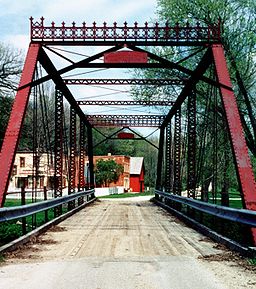 |
Forestville Mystery Cave State Park Forestville Mystery Cave State Park Forestville Mystery Cave State Park is a state park of Minnesota, USA. It contains the village of Forestville which has been restored to a nineteenth century appearance. The Minnesota Historical Society operates it as a historic site. Below ground the park contains Mystery Cave, the longest cave... |
1853–1899 | 1978 | Direct | Restored town with living history Living history Living history is an activity that incorporates historical tools, activities and dress into an interactive presentation that seeks to give observers and participants a sense of stepping back in time. Although it does not necessarily seek to reenact a specific event in history, living history is... reenactors. NRHP National Register of Historic Places The National Register of Historic Places is the United States government's official list of districts, sites, buildings, structures, and objects deemed worthy of preservation... |
| Historic Fort Snelling | Fort Snelling State Park Fort Snelling State Park Fort Snelling State Park is a state park of Minnesota, USA, at the confluence of the Mississippi and Minnesota rivers. Its most notable feature is the historic Fort Snelling, which dates from 1820. The fort itself is operated by the Minnesota Historical Society and requires a separate entrance fee... |
1820–1946 | Direct | Portions of the fort have been restored to their original frontier appearance, while later additions served as barracks for soldiers training during World War II World War II World War II, or the Second World War , was a global conflict lasting from 1939 to 1945, involving most of the world's nations—including all of the great powers—eventually forming two opposing military alliances: the Allies and the Axis... . A National Historic Landmark National Historic Landmark A National Historic Landmark is a building, site, structure, object, or district, that is officially recognized by the United States government for its historical significance... and part of the Mississippi National River and Recreation Area Mississippi National River and Recreation Area The Mississippi National River and Recreation Area protects a and corridor along the Mississippi River from the cities of Dayton and Ramsey, Minnesota to just downstream of Hastings, Minnesota. This includes the stretch of Mississippi River which flows through Minneapolis and St. Paul, Minnesota... . |
||
| James J. Hill House James J. Hill House The James J. Hill House, in Saint Paul, Minnesota, was built by railroad magnate James J. Hill. The house, completed in 1891, is near the eastern end of Summit Avenue near the Cathedral of Saint Paul. The house, for its time, was very large and was the "showcase of St. Paul" until James J. Hill's... |
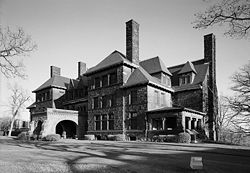 |
St. Paul Saint Paul, Minnesota Saint Paul is the capital and second-most populous city of the U.S. state of Minnesota. The city lies mostly on the east bank of the Mississippi River in the area surrounding its point of confluence with the Minnesota River, and adjoins Minneapolis, the state's largest city... |
1891–1921 | 1978 | Direct | Mansion of railroad magnate James J. Hill James J. Hill James Jerome Hill , was a Canadian-American railroad executive. He was the chief executive officer of a family of lines headed by the Great Northern Railway, which served a substantial area of the Upper Midwest, the northern Great Plains, and Pacific Northwest... . National Historic Landmark National Historic Landmark A National Historic Landmark is a building, site, structure, object, or district, that is officially recognized by the United States government for its historical significance... |
| Jeffers Petroglyphs Jeffers Petroglyphs The Jeffers Petroglyphs site is an outcrop in southwestern Minnesota with pre-contact Native American petroglyphs. The petroglyphs are pecked into rock of the Red Rock Ridge, a -long Sioux quartzite outcrop that extends from Watonwan County, Minnesota to Brown County, Minnesota. The exposed... |
 |
Jeffers Jeffers, Minnesota Jeffers is a city in Amboy Township, Cottonwood County, Minnesota, United States. The population was 369 at the 2010 census.Minnesota State Highway 30 and County Highway 4 are two of the main routes in the community. U.S. Route 71 is nearby.-Geography:... |
1966 | Direct | Exposed rocks bear ancient Native American Native Americans in the United States Native Americans in the United States are the indigenous peoples in North America within the boundaries of the present-day continental United States, parts of Alaska, and the island state of Hawaii. They are composed of numerous, distinct tribes, states, and ethnic groups, many of which survive as... petroglyph Petroglyph Petroglyphs are pictogram and logogram images created by removing part of a rock surface by incising, picking, carving, and abrading. Outside North America, scholars often use terms such as "carving", "engraving", or other descriptions of the technique to refer to such images... s. NRHP National Register of Historic Places The National Register of Historic Places is the United States government's official list of districts, sites, buildings, structures, and objects deemed worthy of preservation... |
|
| Lac qui Parle Mission |  |
Montevideo Montevideo, Minnesota As of the census of 2000, there were 5,346 people, 2,353 households, and 1,444 families residing in the city. The population density was 1,190.5 people per square mile . There were 2,551 housing units at an average density of 568.1 per square mile... |
1835–1854 | Partnership | Reconstructed wooden church where missionaries worked to convert the Dakota Sioux The Sioux are Native American and First Nations people in North America. The term can refer to any ethnic group within the Great Sioux Nation or any of the nation's many language dialects... . NRHP National Register of Historic Places The National Register of Historic Places is the United States government's official list of districts, sites, buildings, structures, and objects deemed worthy of preservation... |
|
| Lower Sioux Agency | Lower Sioux Indian Reservation Lower Sioux Indian Reservation The Lower Sioux Indian Reservation, also known as the Mdewankanton Tribal Reservation, is an Indian reservation located along the southern bank of the Minnesota River in Redwood County, Minnesota, east of the city of Redwood Falls, just south of Morton... |
1853– | Partnership | Museum depicting the lives of Dakota Sioux The Sioux are Native American and First Nations people in North America. The term can refer to any ethnic group within the Great Sioux Nation or any of the nation's many language dialects... people before and after the Dakota War of 1862 Dakota War of 1862 The Dakota War of 1862, also known as the Sioux Uprising, was an armed conflict between the United States and several bands of the eastern Sioux. It began on August 17, 1862, along the Minnesota River in southwest Minnesota... . NRHP National Register of Historic Places The National Register of Historic Places is the United States government's official list of districts, sites, buildings, structures, and objects deemed worthy of preservation... |
||
| Marine Mill Marine Mill Marine Mill is a historic site in Marine on St. Croix, Minnesota, USA. It was Minnesota's first commercial sawmill, which operated from 1839 to 1895 on a bluff overlooking the St. Croix River. The buildings were torn down when the mill closed, and today all that is visible are the overgrown ruins... |
Marine on St. Croix Marine on St. Croix, Minnesota Marine on St. Croix is a city in Washington County, Minnesota, United States. The population was 689 at the 2010 census.-Geography:According to the United States Census Bureau, the city has a total area of , of which, of it is land and of it is water. Minnesota State Highway 95 serves as a main... |
1839–1895 | Self-guided | Ruins of Minnesota's first commercial sawmill Sawmill A sawmill is a facility where logs are cut into boards.-Sawmill process:A sawmill's basic operation is much like those of hundreds of years ago; a log enters on one end and dimensional lumber exits on the other end.... . NRHP National Register of Historic Places The National Register of Historic Places is the United States government's official list of districts, sites, buildings, structures, and objects deemed worthy of preservation... |
||
| Mill City Museum Mill City Museum Mill City Museum is a Minnesota Historical Society museum in Minneapolis. It opened in 2003, built in the ruins of the Washburn "A" Mill next to Mill Ruins Park on the banks of the Mississippi River... |
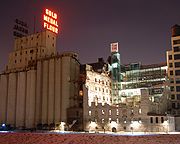 |
Minneapolis Minneapolis, Minnesota Minneapolis , nicknamed "City of Lakes" and the "Mill City," is the county seat of Hennepin County, the largest city in the U.S. state of Minnesota, and the 48th largest in the United States... |
1874–1965 | Museum of the flour milling industry that built Minneapolis, within the ruins of the Washburn "A" Mill, a National Historic Landmark National Historic Landmark A National Historic Landmark is a building, site, structure, object, or district, that is officially recognized by the United States government for its historical significance... . Part of the Mississippi National River and Recreation Area Mississippi National River and Recreation Area The Mississippi National River and Recreation Area protects a and corridor along the Mississippi River from the cities of Dayton and Ramsey, Minnesota to just downstream of Hastings, Minnesota. This includes the stretch of Mississippi River which flows through Minneapolis and St. Paul, Minnesota... . |
||
| Mille Lacs Indian Museum Mille Lacs Indian Museum The Mille Lacs Indian Museum is a museum dedicated to the Mille Lacs Band of Ojibwe's history, culture, and contemporary life. It officially opened to the public on May 18, 1996... |
Mille Lacs Indian Reservation Mille Lacs Indian Reservation Mille Lacs Indian Reservation is the land-base for the Mille Lacs Band of Ojibwe in Central Minnesota, about 100 miles north of Minneapolis-St. Paul... |
Direct | Museum of the history and culture of the Mille Lacs Band of Ojibwe Mille Lacs Band of Ojibwe The Mille Lacs Band of Ojibwe , also known as the Mille Lacs Band of Chippewa Indians or the Mille Lacs Band of Minnesota Chippewa Tribe, is an Ojibwa tribe located in Minnesota. The tribe boasts 3,942 tribal members as of July, 2007... . |
|||
| Minnehaha Depot |  |
Minneapolis Minneapolis, Minnesota Minneapolis , nicknamed "City of Lakes" and the "Mill City," is the county seat of Hennepin County, the largest city in the U.S. state of Minnesota, and the 48th largest in the United States... |
1875–1963 | 1964 | Partnership | Former train station near Minnehaha Falls Minnehaha Falls Minnehaha Creek is a tributary of the Mississippi River located in Hennepin County, Minnesota that extends from Lake Minnetonka in the west and flows east for 22 miles through several suburbs west of Minneapolis and then through south Minneapolis. Including Lake Minnetonka, the watershed for the... with "gingerbread" Victorian architecture Victorian architecture The term Victorian architecture refers collectively to several architectural styles employed predominantly during the middle and late 19th century. The period that it indicates may slightly overlap the actual reign, 20 June 1837 – 22 January 1901, of Queen Victoria. This represents the British and... . Operated by the Minnesota Transportation Museum Minnesota Transportation Museum The Minnesota Transportation Museum is a transport museum in Saint Paul, Minnesota.The MTM operates several heritage transportation sites in Minnesota and one in Wisconsin... . |
| Minnesota History Center Minnesota History Center The Minnesota History Center is a museum and library which serves as the headquarters for the Minnesota Historical Society. It is located near downtown Saint Paul, Minnesota and is considered one of the finest public buildings of Minnesota.... |
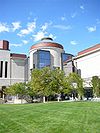 |
St. Paul Saint Paul, Minnesota Saint Paul is the capital and second-most populous city of the U.S. state of Minnesota. The city lies mostly on the east bank of the Mississippi River in the area surrounding its point of confluence with the Minnesota River, and adjoins Minneapolis, the state's largest city... |
Direct | Minnesota Historical Society's headquarters, with permanent exhibits about Minnesota, changing exhibits about national history, and a library. | ||
| Minnesota State Capitol Minnesota State Capitol The Minnesota State Capitol is located in Minnesota's capital city, Saint Paul, and houses the Minnesota Senate, Minnesota House of Representatives, the Office of the Attorney General and the Office of the Governor... |
 |
St. Paul Saint Paul, Minnesota Saint Paul is the capital and second-most populous city of the U.S. state of Minnesota. The city lies mostly on the east bank of the Mississippi River in the area surrounding its point of confluence with the Minnesota River, and adjoins Minneapolis, the state's largest city... |
1905–present | 1969 | Direct | Tours and exhibits of the state's seat of government. NRHP National Register of Historic Places The National Register of Historic Places is the United States government's official list of districts, sites, buildings, structures, and objects deemed worthy of preservation... |
| Morrison Mounds | Battle Lake Battle Lake, Minnesota -External links:*http://www.ci.battle-lake.mn.us/http://firstbaptistbattlelake.org... |
1968 | Preservation | Includes the oldest burial mound Tumulus A tumulus is a mound of earth and stones raised over a grave or graves. Tumuli are also known as barrows, burial mounds, Hügelgrab or kurgans, and can be found throughout much of the world. A tumulus composed largely or entirely of stones is usually referred to as a cairn... in Minnesota. NRHP National Register of Historic Places The National Register of Historic Places is the United States government's official list of districts, sites, buildings, structures, and objects deemed worthy of preservation... |
||
| North West Company Post North West Company Post The North West Company Fur Post is a reconstructed fur trade post on the Snake River west of Pine City, Minnesota. The post was established by John Sayer, a partner in the North West Company, in the fall of 1804, and built by his crew of voyageurs. The site operated for several years, although... |
Pine City Pine City, Minnesota Pine City is a city in Pine County, Minnesota, United States. The population was 3,123 at the 2010 census. Pine City is the county seat of, and the largest city in, Pine County... |
1804 | Direct | Recreated North West Company North West Company The North West Company was a fur trading business headquartered in Montreal from 1779 to 1821. It competed with increasing success against the Hudson's Bay Company in what was to become Western Canada... trading post Trading post A trading post was a place or establishment in historic Northern America where the trading of goods took place. The preferred travel route to a trading post or between trading posts, was known as a trade route.... and Ojibwe encampment. NRHP National Register of Historic Places The National Register of Historic Places is the United States government's official list of districts, sites, buildings, structures, and objects deemed worthy of preservation... |
||
| Oliver H. Kelley Farm Oliver H. Kelley Homestead The Oliver H. Kelley Farm is a historic farmstead once owned by Oliver Hudson Kelley, one of the founders of the Order of Patrons of Husbandry. The farmstead is a U.S. National Historic Landmark, which also places it on the National Register of Historic Places. The farm is currently operated as a... |
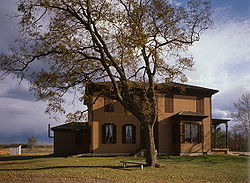 |
Elk River Elk River, Minnesota As of the census of 2000, there were 16,447 people, 5,664 households, and 4,400 families residing in the city. Recent estimates show the population at 21,329 as of 2005. The population density was 385.5 people per square mile . There were 5,782 housing units at an average density of 135.5 per... |
1850–1901 | 1961 | Direct | Frontier farmstead of Oliver Hudson Kelley Oliver Hudson Kelley Oliver Hudson Kelley is considered the "Father" of the Order of Patrons of Husbandry.-Biography:In Boston, he moved to the Minnesota frontier in 1849, where he became a farmer... , one of the founders of the National Grange of the Order of Patrons of Husbandry. National Historic Landmark National Historic Landmark A National Historic Landmark is a building, site, structure, object, or district, that is officially recognized by the United States government for its historical significance... |
| Sibley House Historic Site Sibley House Historic Site The Sibley House Historic Site is the site of Henry Hastings Sibley's home, who was the regional manager of the American Fur Company and Minnesota's first governor. It is one of the 26 historical sites that are operated by the Minnesota Historical Society. Located in what is now the city of... |
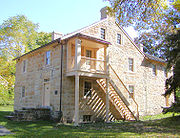 |
Mendota Mendota, Minnesota Mendota is a city in Dakota County, Minnesota, United States. The name comes from the Dakota word for "where the waters meet." The population was 198 at the 2010 census.-History:... |
1838–1910 | Direct | Homes of Henry Hastings Sibley Henry Hastings Sibley Henry Hastings Sibley was the first Governor of the U.S. state of Minnesota.-Early life and education:... , Minnesota's first state governor, and fur trader Jean-Baptiste Faribault Jean-Baptiste Faribault Jean-Baptiste Faribault was a trader with the Indians and early settler in Minnesota.His father, Barthélemy Faribault, a lawyer of Paris, France, settled in Canada towards the middle of the 18th century and served as military secretary to the French army in Canada... . NRHP National Register of Historic Places The National Register of Historic Places is the United States government's official list of districts, sites, buildings, structures, and objects deemed worthy of preservation... and part of the Mississippi National River and Recreation Area Mississippi National River and Recreation Area The Mississippi National River and Recreation Area protects a and corridor along the Mississippi River from the cities of Dayton and Ramsey, Minnesota to just downstream of Hastings, Minnesota. This includes the stretch of Mississippi River which flows through Minneapolis and St. Paul, Minnesota... . |
|
| Split Rock Lighthouse | Split Rock Lighthouse State Park Split Rock Lighthouse State Park Split Rock Lighthouse State Park is a state park of Minnesota, USA, on the North Shore of Lake Superior. It is best known for the picturesque Split Rock Lighthouse, one of the most photographed lighthouses in the United States... |
1910–1969 | 1976 | Direct | Clifftop lighthouse Lighthouse A lighthouse is a tower, building, or other type of structure designed to emit light from a system of lamps and lenses or, in older times, from a fire, and used as an aid to navigation for maritime pilots at sea or on inland waterways.... on Lake Superior Lake Superior Lake Superior is the largest of the five traditionally-demarcated Great Lakes of North America. It is bounded to the north by the Canadian province of Ontario and the U.S. state of Minnesota, and to the south by the U.S. states of Wisconsin and Michigan. It is the largest freshwater lake in the... restored to its 1920s appearance. National Historic Landmark National Historic Landmark A National Historic Landmark is a building, site, structure, object, or district, that is officially recognized by the United States government for its historical significance... |
|
| Stumne Mounds | Pine City Pine City, Minnesota Pine City is a city in Pine County, Minnesota, United States. The population was 3,123 at the 2010 census. Pine City is the county seat of, and the largest city in, Pine County... |
1968 | Preservation | Group of linear burial mounds Tumulus A tumulus is a mound of earth and stones raised over a grave or graves. Tumuli are also known as barrows, burial mounds, Hügelgrab or kurgans, and can be found throughout much of the world. A tumulus composed largely or entirely of stones is usually referred to as a cairn... near the Snake River Snake River (St. Croix River) The Snake River is a tributary of the St. Croix River in east central Minnesota in the United States. It is one of three streams in Minnesota with this name . Its name is a translation from the Ojibwa Ginebigo-ziibi after the Dakota peoples who made their homes along this river... . NRHP National Register of Historic Places The National Register of Historic Places is the United States government's official list of districts, sites, buildings, structures, and objects deemed worthy of preservation... |
||
| Traverse des Sioux Traverse des Sioux Traverse des Sioux is a historic site in the U.S. state of Minnesota. Once part of a preindustrial trade route, it commemorates that route, a busy river crossing on it, a nineteenth century settlement, trading post, and mission at that crossing place, a transshipment point for pelts in fur trading... |
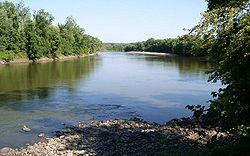 |
St. Peter St. Peter, Minnesota St. Peter is a city in Nicollet County, Minnesota, United States. The population was 11,196 at the 2010 census. It is the county seat of Nicollet County.St... |
1981 | Self-guiding | Site of a river ford Ford (crossing) A ford is a shallow place with good footing where a river or stream may be crossed by wading or in a vehicle. A ford is mostly a natural phenomenon, in contrast to a low water crossing, which is an artificial bridge that allows crossing a river or stream when water is low.The names of many towns... , the signing of the Treaty of Traverse des Sioux Treaty of Traverse des Sioux The Treaty of Traverse des Sioux was a treaty signed on July 23, 1851, between the United States government and Sioux Indian bands in Minnesota Territory by which the Sioux ceded territory. The treaty was instigated by Alexander Ramsey, the first governor of Minnesota Territory, and Luke Lea,... , and a former town. NRHP National Register of Historic Places The National Register of Historic Places is the United States government's official list of districts, sites, buildings, structures, and objects deemed worthy of preservation... |
|
| Upper Sioux Agency | Upper Sioux Agency State Park Upper Sioux Agency State Park Upper Sioux Agency State Park is a Minnesota state park on the Minnesota River, south of Granite Falls. It preserves the site of the historic Yellow Medicine Agency which was destroyed in the Dakota War of 1862.-External links:*... |
1854–1862 | 1969 | Preservation | Location of a federal agency established to convert Dakotas Sioux The Sioux are Native American and First Nations people in North America. The term can refer to any ethnic group within the Great Sioux Nation or any of the nation's many language dialects... to a Euro-American farming lifestyle, but destroyed in the Dakota War of 1862 Dakota War of 1862 The Dakota War of 1862, also known as the Sioux Uprising, was an armed conflict between the United States and several bands of the eastern Sioux. It began on August 17, 1862, along the Minnesota River in southwest Minnesota... . NRHP National Register of Historic Places The National Register of Historic Places is the United States government's official list of districts, sites, buildings, structures, and objects deemed worthy of preservation... |
|
| W.W. Mayo House Dr. William W. Mayo House The Dr. William W. Mayo House, located at 118 North Main Street in Le Sueur, Minnesota is listed on the National Register of Historic Places . It was built in 1859 by James Mayo and his brother, William Worrall Mayo who emigrated from Salford, United Kingdom, to the United States in 1846 and became... |
 |
Le Sueur Le Sueur, Minnesota As of the census of 2000, there were 3,922 people, 1,545 households, and 1,025 families residing in the city. The population density was 879.0 people per square mile . There were 1,589 housing units at an average density of 356.1 per square mile... |
1859– | Partnership | Home built by William Worrall Mayo William Worrall Mayo William Worrall Mayo was a British medical doctor and chemist, best known for establishing the private medical practice that later evolved into the Mayo Clinic. He was a descendant of a famous English chemist, John Mayow. His sons, William James Mayo and Charles Horace Mayo, joined the private... , founder of the Mayo Clinic Mayo Clinic Mayo Clinic is a not-for-profit medical practice and medical research group specializing in treating difficult patients . Patients are referred to Mayo Clinic from across the U.S. and the world, and it is known for innovative and effective treatments. Mayo Clinic is known for being at the top of... , and later home of Carson Nesbit Cosgrove, founder of the Green Giant Green Giant Green Giant and Le Sueur are brands of frozen and canned vegetables owned by General Mills. The mascot of Green Giant is the Jolly Green Giant.... food company. NRHP National Register of Historic Places The National Register of Historic Places is the United States government's official list of districts, sites, buildings, structures, and objects deemed worthy of preservation... |
External links
- Minnesota Historical Society
- Placeography – wiki operated by the Minnesota Historical Society

